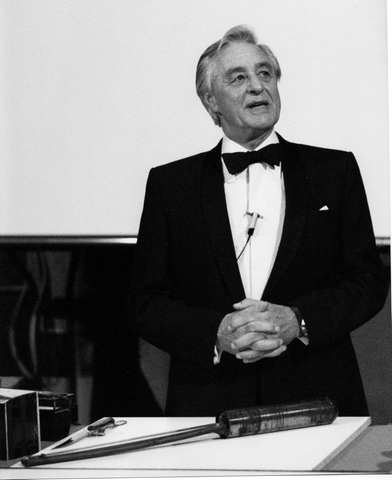Lord George Porter FRSC FRS OM (6th December 1920–31st August 2002)
Frank Wilkinson*a and David Phillipsb
aEditor in Chief, Photochemical and Photobiological Sciences, 18 Cecil Road, Norwich, UK NR1 2QL
bHofmann Professor of Chemistry, Department of Chemistry, I.C.S.T.M., Exhibition Road, London, UK SW7 2AY
 | ||
| Plate1 Lord George Porter FRSC FRS OM (1920–2002) | ||
George Porter was an inspiring research supervisor and colleague who exploited his technique with extraordinary success. He continued his research in Cambridge with a series of co-workers, studying, for example, the fragmentation of simple organic molecules, the explosion reaction of hydrogen and oxygen and discovering for the first time the diatomic radical chlorine monoxide (ClO). The importance of this species in reactions in the upper atmosphere, which are responsible for the ‘ozone hole’ above Antarctica has recently been established. Upon moving to Sheffield University (1955–1966) he followed up earlier work in Cambridge where he was the first to detect triplet states of large organic molecules in the gas phase and in dilute fluid solution; with ground-breaking transient absorption studies of the triplet states of benzene, naphthalene, anthracene, chloranil, and of acetone, on triplet–triplet energy transfer, on quenching of excited states by oxygen and other paramagnetic species and on the measurement of the acid dissociation constants of excited states and of radicals. His papers on the mechanism of atom recombination, diffusion studies in viscous media and the absorption spectra of benzyl, of phenyl and of anilino radicals were of the highest standard as were almost all of his publications. Porter and colleagues also carried out wonderfully original research on the mechanism of photochemical reactions particularly of quinones and ketones.
In 1966 Porter became Director of the Royal Institution of Great Britain (the RI) and moved to London where he was proud to be able to use the desk that Michael Faraday, a previous director, had used more than a century earlier. He refurbished the Davy–Faraday research laboratories in order to be able to continue his innovative research, being one of the first to use lasers and optical delay lines, dependent on the finite speed of light, to pump and probe on nanosecond and later on picosecond timescales. Although Porter continued research of the highest international standard on fundamental photochemical processes he became increasingly interested in photobiology and solar energy conversion. In this connection he published many important papers on in vivo photosynthesis and these together with those on the photo-catalysed decomposition of water to produce hydrogen and oxygen were characteristically outstanding.
Porter was a clear lucid speaker and it was an enlightening experience to hear his lectures and discussion contributions on photochemistry at the numerous conferences he frequented throughout the second half of the twentieth century. He was also a gifted teacher, passionately interested in communicating science to the general public and to young people in particular. Thus he brought new impetus to the traditional RI Christmas Lectures by persuading the BBC to broadcast these annually on television. He also helped promote (and select) the Young Scientist of the Year, on TV. George Porter was such a distinguished scientist that he received many honours including a knighthood in 1972 and being elected President of the Royal Society in 1985, the same year as he led the British Association for the Advancement of Science, while still being Director of the RI, a unique combination of prestigious posts. He was appointed a member of the Order of Merit in 1989 and created a life peer as Lord Porter of Luddenham in 1990.
Porter was instrumental in founding the Centre for Photomolecular Sciences at Imperial College, where he was Chairman from 1990–2002, having left the RI in 1988. The following is taken from the Introduction he wrote for their web site “Photomolecular processes are almost as old as the earth itself. Photochemical processes created, from simple gases of the primitive atmosphere, the larger molecules needed to build living matter. Photosynthesis began to create the earth's biosphere three and a half billion years ago; it supplies the energy for life today, as well as for most of modern technology. …… some of the areas of most interest at the present time are: spectroscopy of ultrafast phenomena down to femtosecond times; development of pulsed lasers; photovoltaic cells; photosynthesis; photomedicine and vision; environmental photochemistry; solar energy.” Many readers would echo these words.
George Porter was highly supportive of research students, friends and colleagues. He will be remembered, by all photochemists, since The Porter Medal, in honour of Lord Porter, is awarded biannually at the IUPAC Photochemistry Symposium to the candidate who, in the opinion of the Presidents of the Inter-American Photochemistry Society, The Japanese Photochemistry Association, and the European Photochemistry Association, has made the most prestigious contribution to the field of Photochemistry.
There is no doubt that Porter's pioneering studies have enhanced enormously scientific knowledge over the last half century as witnessed by the fact that several other workers have been awarded Nobel prizes for work dependent on Porter's great contribution to Photochemical and Photobiological Sciences. He will be sorely missed.
To acknowledge the enormous contribution made to Photochemistry and Photobiology by George Porter, his ex-colleagues, ex-students and collaborators are invited to dedicate articles to George to be included together in one or two special issues of PPS. It is intended to collect these dedicated papers together in the April/May 2003 issues of PPS. Manuscripts therefore need to be submitted by 31st December 2002. Manuscripts received after this date may not appear in the special issues, but will be published in later issues of PPS and may still carry a dedication. Papers should be submitted via the internet www.rsc.org/submissions or by e-mail to pps@rsc.org and will of course be subject to normal refereeing.
| This journal is © The Royal Society of Chemistry and Owner Societies 2002 |
